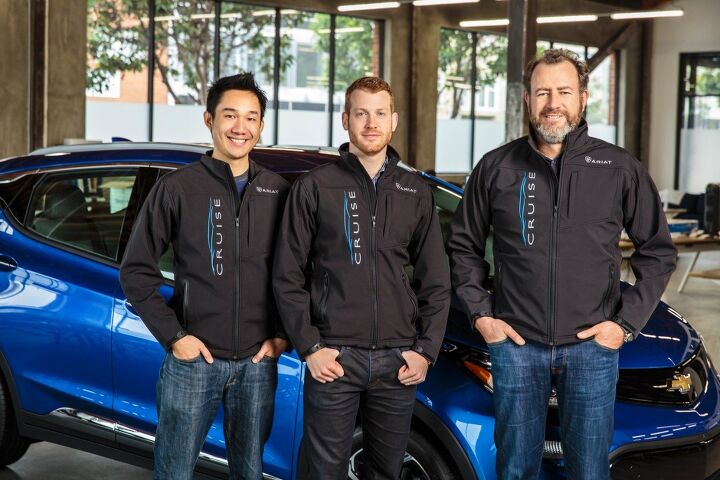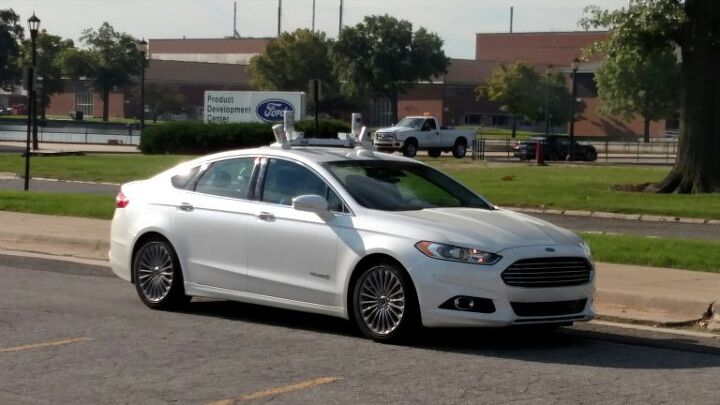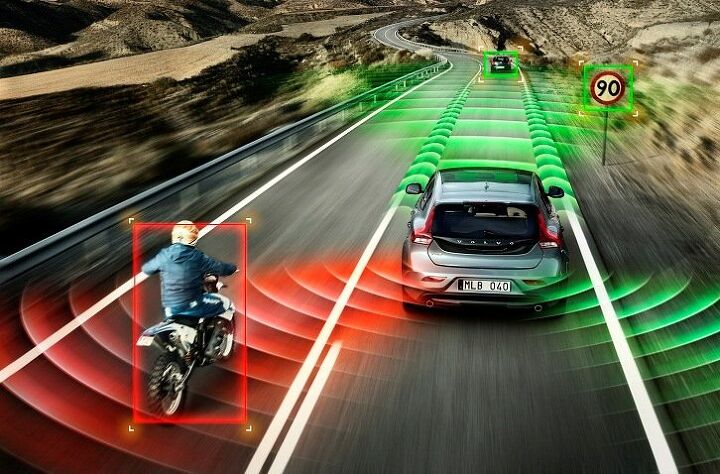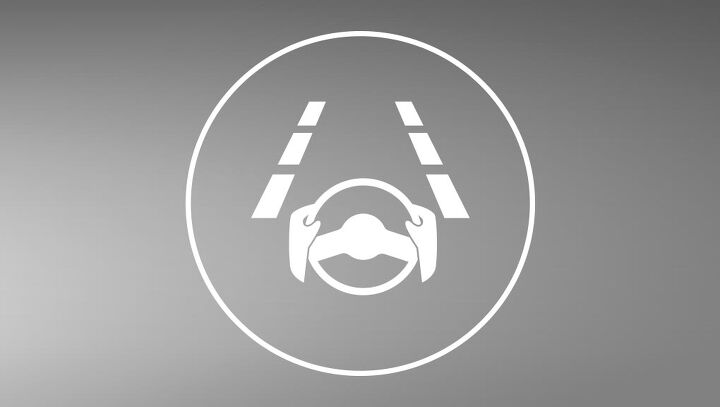#Self-drivingCars
GM's Self-driving Team Fires Back at Tesla With New Autonomous Bolt Video
General Motors’ self-driving startup, Cruise Automation, has trickled out dash cam videos of an autonomous Chevrolet Bolt milling around San Francisco since February. The video quality was poor and it wasn’t anything we hadn’t already seen from a self-driving car. Tesla went so far as to call tech startups like Cruise Automation and Otto “small teams of programmers with little more than demoware” and scolded Ford, GM, and Uber for investing billions of dollars into “unproven” projects.
However, Cruise’s most recent video seems to show that it has made some legitimate progress in the last three months. Set at night, the clip shows the self-driving Bolt navigating a dense urban environment while avoiding collisions with cyclists, pedestrians, and even a raccoon.
We have to take General Motors’ word for there being zero human intervention, since we never get a clear view of the steering wheel, but the company has assured us that is the case. We also noticed the Bolt never makes a single right turn on red, even when it seemed safe to do so, and reached out to GM to ask why.
Which Companies Are Winning the Autonomous Vehicle Race?
Ford’s head of research, Ken Washington, suggests that the general public won’t be able to buy a fully autonomous vehicle until sometime between 2026 and 2031. That’s a little later than CEO Mark Fields’ claim of “by 2025.”
We already know that companies are making timeline promises they can’t really keep but, with Ford currently working on an autonomous ride-sharing fleet to be used on public roadways in 2021, the amount of wiggle-room in Washington’s estimate is a little unsettling. If the technology is sufficient to shuttle people around in a taxi, shouldn’t it be equally adept in accomplishing that task regardless of what seat the human is occupying? Exactly who is leading in this race?
QOTD: When Should Your Self-Driving Car Ask For Help?
Don’t look now, but it would appear that SkyNet has finally arrived — in an expert system designed to make certain judgments during autonomous vehicle operation. NetworkWorld’s breathless report states, “Basically the patented IBM system employs onboard sensors and artificial intelligence to determine potential safety concerns and control whether self-driving vehicles are operated autonomously or by surrendering control to a human driver.” We don’t need to worry about preserving John Connor’s life, or even conceiving that life (with your friend’s mom!) quite yet, however.
The definition of “artificial intelligence” that NetworkWorld is using could just as easily apply to your “smart”phone’s various character-recognition systems. But the problem that this so-called AI purports to solve is one that has far-reaching implications for the timeline, and methods, by which autonomous vehicle operation enters the mainstream.
And it leads to a very simple question.
Autonomous Vehicle Legislation Could Be Modeled After Vaccines
Every time we write an article about autonomous vehicles, our comments section is quickly populated with discourse over how litigation would be handled in the event of a crash. Who do you sue?
You can’t fault the driver, because a truly self-driving car takes them out of the equation. Suing the manufacturer doesn’t work because, assuming the system functions properly, they’re still saving lives and shouldering all of the risk would discourage companies from bothering to pursue the technology.
However, autonomous accidents will happen and someone is inevitably going to appear in a courtroom. The justice system has to decide how that will be handled, but Automotive News’ Katie Burke has an interesting solution. It relates to how the United States deals with legal actions involving vaccinations.
New Transportation Secretary Has Obama's Self-driving Guidelines Under a Microscope
Last September, the Obama administration released a list of 15 guidelines to all automakers looking to develop and market a self-driving vehicle. Companies were asked to voluntarily follow the rules and report back to the federal government with useful information. It was a somewhat confusing exercise and raised a flurry of questions and concerns.
At the time, Obama wrote that the rules would provide “guidance that the manufacturers developing self-driving cars should follow to keep us safe.” Not only would the totally voluntary rules show the government that certain vehicles were safe for public roads, but it would show every interested citizen “how they’re doing it.”
That list is now in the hands of newly minted Transportation Secretary Elaine Chao. While the two administrations differ in many areas, Chao seems to be of a similar mind as Obama on the issue of self-driving cars. That doesn’t mean the guidelines won’t change.
GM Lobbyist Says Company Doesn't Push Bills, Lawmakers Disagree
For now, legislation restricting the use of those pesky self-driving cars is mainly up to individual states. Because no one wants an experimental, untested car piloting their local roadways, states have erected legislative safety barriers that, for the most part, restrict pilot projects in certain areas, or on certain roads.
As everyone waits for the National Highway Traffic Safety Administration to make up its mind and put blanket regulations in place, an angry chorus of complaints from Silicon Valley startups is growing louder, accusing state lawmakers of favoring the old guard when it comes to fostering automotive technology.
Only naturally, concerns about corporate money influencing government decisions arose. One automaker’s political action fund seems more active than others
Autonomous Vehicles Are a Snoozefest and Ford Engineers Can't Stay Awake
Apparently, it’s not just Uber drivers who enjoy extended naps behind the wheel.
Ford engineers, tapped to put the company’s self-driving technology on the fast track to production, are taking the off-ramp to Slumberville so often that the company has had to get other engineers to devise ways of keeping them awake.
It turns out that riding in the driver’s seat of a self-driving car is as conducive to glassy-eyed lethargy as reading about “mobility solutions.”
'Startling Paranoia': Ex-Autopilot Director Sued by Tesla, Fires Back
The former director of Tesla’s Autopilot program has choice words for his former employer.
Sterling Anderson is being sued by Tesla for stealing confidential information, which he allegedly put to use at a new autonomous vehicle start-up. According to Bloomberg, the electric automaker isn’t happy about his attempts to hire away Tesla employees, either.
In his response to the suit, Anderson doesn’t have very nice things to say about Tesla.
No Fixed Abode: Five Amazing Things That Are Easier to Invent Than an Autonomous Car
It’s neither on-message for this site nor terribly interesting to my readers, which is why I rarely mention it, but I have been almost feverishly interested in matters of artificial intelligence, machine consciousness, and advanced language parsing for a very long time.
Thirty-five years ago, I tried to write a very simple sentence parser and response generator for the Atari 800 for my school science fair. The effort failed miserably, in large part because AtariBASIC didn’t really have any usable tools for text handling — and because I was nine years old and had the attention span of a fruit fly.
The night before the science fair, I admitted defeat and decided to do something else: I wrote a quick program that would give pre-programmed responses to certain questions.
The next morning, I demonstrated my program to a couple of nuns. I asked them a couple of leading questions to get them to pick the discussion topic I wanted, then I had them type the questions in. The amazingly intelligent Atari responded in full sentences! Not even the utter pathos of my quickly sketched cardboard sign behind it could keep me from getting an A+. What amuses me, in retrospect, was that the nuns weren’t really all that shocked at the idea that an 8-bit computer could parse language and give reasonable answers. Had I demoed this program to anybody who understood technology, they’d have labeled me a genius or a fraud. But to the nuns, passing the Turing test was about as tough as making an artificial volcano. Blame the movies, I guess.
The problem with every “autonomous” car that has appeared so far is simple: they are all equal to my childhood Atari program. Real autonomous operation is a hugely difficult problem. I’d like to illustrate this for you by listing five rather astounding technical feats that will be easier to accomplish than true vehicular autonomy.
Tesla Adds Fully Self-Driving Hardware to All Models, But You'll Still Do The Work
Yesterday, after a brief delay and weeks of teasing, Tesla Motors said it will equip all of its new vehicles with the hardware needed for fully autonomous driving. Starting yesterday, the technology comes standard on every model, including the upcoming Model 3 sedan.
But that doesn’t mean you can use it anytime soon.
Michigan's Self-Driving Dream Is Now Just a Vote Away
If the House approves it, Michigan will become the first state to allow autonomous vehicles to drive on certain public roads, at any time, for any purpose.
According to the Detroit Free Press, the state Senate has unanimously approved four bills aimed at making Michigan the self-driving mecca of the U.S., giving consent for autonomous vehicles to operate on 122 miles of public roads, not just on closed courses during pilot projects.
Volvo Partners With Uber, Unleashes Self-Driving XC90s in Pittsburgh
Volvo is partnering with ride-hailing service Uber, a $300 million deal expected to spawn a fleet of self-driving vehicles on U.S. roads.
Both companies plan to develop their own autonomous technology using a Volvo “base” vehicle, but Pittsburgh will see a crop of self-driving Swedes by the end of the year, Automotive News reports.
Elon Musk's Future Vision: Your Tesla Gets a Day Job, and Why That Might Not Be a Good Idea
In his Master Plan, Part Deux, some of Tesla CEO Elon Musk’s visions make a lot of sense, like a compact SUV based on the Model 3 platform, and a pickup truck, which will presumably have more than enough torque to haul around a big load (and plenty of space for a big battery pack).
That’s not at all what I want to talk about. Instead, I want to talk about some of the more speculative parts of the Musk vision: the self-driving vision. ( I first wrote about some of the dystopian aspects of self-driving cars for TTAC in 2010.)
Musk wants you, the owner of a Tesla, to click a button and have your self-driving car go off and Uber itself during the day while you’re at work, earning you money. It will come back to you at the end of the day, ready for you to use again. This vision is going to have a very harsh collision with reality.
No Fixed Abode: What's the Auto-Point of It All?
One of the first things any child learns in the modern technological era is that there are tools for which the true purpose is explicitly stated and tools for which the true purpose is hidden behind some obfuscating official language, legal fiction, or disingenuous disclaimer. Examples of the former: shovels, over-and-under trapshooting shotguns, noise-canceling headphones. Examples of the latter: BitTorrent, “professional” lock-picking kits on Massdrop, the Hitachi Magic Wand.
With the simultaneous democratization of tech and increased frequency of tech-related legislation, more and more things are falling into the category of “used for purposes other than intended, or in a manner other than suggested.” Nobody ever lets the FAA know that they’re going to be flying a Phantom drone over a motocross track, nobody ever deletes their MP3s when they sell their CDs back to Half Price Books, and nobody ever takes the Yoshimura pipe off their GSX-R1000 when they leave Willow Springs and ride back home.
From the moment that the Tesla “Autopilot” feature was introduced, with its copious disclaimers and strident request that the owner keep his hands on the wheel and continue to act just like he was driving the thing himself, the whole world has treated Autopilot like it was Napster. Oh, sure, I’m just going to keep looking ahead with my hands on the wheel, wink-wink, nudge-nudge. The near-universal assumption, one I’ve seen echoed by dozens of Tesla owners, is that Autopilot is, in fact, a functioning autopilot system and all the disclaimers are just there to keep the lawyers happy.
What if that’s not the case at all?
Fiat-Chrysler Could Partner With Uber on Self-Driving Cars: Report
Fiat Chrysler Automobiles CEO Sergio Marchionne could be on the cusp of a new (corporate) romance.
The automaker is talking with ride-sharing megaprovider Uber about join forces on a self-driving vehicle venture, according to Automotive News. Sources close to the matter say those talks are in the early phase, but a agreement could be announced before the end of the year.





























Recent Comments